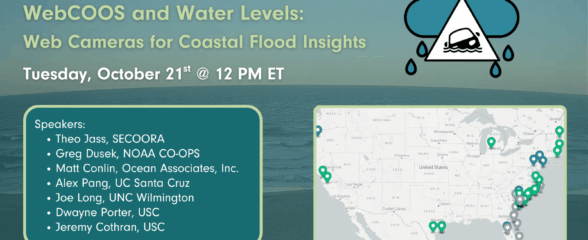**To learn more about this project, please join us for a webinar on October 26 at noon ET. Click here to reserve your spot.**
Florida Bay, located along the western side of the Florida Keys, contains 10% of the world’s seagrass. Variations in temperature and salinity have led to several mass seagrass die-offs since the 1980s. Fishes that depend on seagrass to survive, such as Spotted Seatrout, are equally vulnerable to temperature fluctuations.
Jonathan Rodemann, a Ph.D. candidate at Florida International University, is focusing his research on habitat use by Spotted Seatrout in Rankin Basin, located in north-central Florida Bay. His objectives are to quantify how seasonal and daily changes in temperature drive fish movement and to determine whether habitat transformation due to seagrass die-off, prey redistribution, and temperature are influencing fish distribution within the basin. This research is made possible through a fisheries research grant from SECOORA and the FACT Network.
While results are still preliminary, Rodemann found that Spotted Seatrout spend more time in an area when the temperature is cooler (below 30°C/86°F), such as at dawn and during the wet season (November – January). Dawn, approximately 6:00 – 7:00 AM, seems an optimum time for food capture for seatrout. This might be due to reduced energy demands due to lower metabolic rates that accompany colder water. Rodemann noted that when temperatures approach the upper extremes in the Dry and Early Wet seasons (average of 30°C/86°F), Spotted Seatrout may have higher metabolic rates and therefore a lower aerobic scope to perform vital activities such as feeding. Higher temperatures create less optimal conditions, impacting seatrout movement, space use, and survival. Until now, scientists have lacked the infrastructure to study the relationship between temperature and fish movement within Florida Bay.




From left to right: Jonathan Rodemann, Florida International University, holds a Spotted Seatrout that was tagged and released in Florida Bay (left), Rodemann inserts an acoustic tag into a Spotted Seatrout (top-center), Rodemann deploying an acoustic receiver in Florida Bay (bottom-center), and map of Florida Bay outlined in black and Rankin Basin in red (right). Image credit: Jonathan Rodemann
New Research Infrastructure in Florida Bay
Temperature loggers and acoustic telemetry data are used by Rodemann to evaluate seatrout response to temperature change and habitat disturbance in Rankin Basin.
Sixteen temperature loggers that record hourly water temperature were placed in Rankin Basin along with an array of 29 Innovasea acoustic receivers, which record tagged fish movement. Rodemann and his team are tracking 75 fish tagged with Innovasea ultrasonic pingers. When a fish tagged with an acoustic implant swims near an acoustic receiver, the location of the fish’s movement is recorded. By using both location tracking and temperature loggers, Rodemann’s team seeks a better understanding of not just where Spotted Sea Trout reside, but when and why.
For more information on acoustic telemetry visit The FACT Network.
Future Research
Mr. Rodemann will further this research by mapping seagrass throughout Rankin Basin and modeling seagrass fragmentation and habitat loss under different temperature conditions and the associated impacts to Spotted Seatrout. Mr. Rodemann’s research and similar research projects are crucial to understanding the impacts of climate change on fish in order to develop effective management and conservation strategies.
Donors Contribute to Florida Bay Research
“I am really fortunate to be working on this project. Human impact on the seagrass and fish of Florida Bay is a recurring theme, and helping figure out how to fix these problems is an honor.”
Jonathan Rodemann
The funding for this award is provided through the generosity of SECOORA donors, The Curtis and Edith Munson Foundation, Ocean Tracking Network, Innovasea, the SECOORA Education and Outreach Committee, and many individual donors.
Related news

SECOORA Webinar | WebCOOS and Water Levels: Web Cameras for Coastal Flood Insights
On October 21st at 12 PM ET, SECOORA is hosting a webinar with investigators from the Webcam Coastal Observation System (WebCOOS) project team and the WebCOOS Project Manager. Web cameras are a low-cost technology that can be used to document flooding impacts to coastal communities. Register here.

SECOORA Funding Opportunity Announcement: Letters of Intent Solicitation
SECOORA will submit a coordinated regional proposal in response to the anticipated FY 2026 Implementation of the U.S. Integrated Ocean Observing System (IOOS) funding opportunity. Letters of Intent to be considered for inclusion in SECOORA’s full proposal are due September 9, 2025.

SECOORA Hosts the First Surface Elevation Table (SET) Community of Practice Virtual Workshop
The SECOORA SET Workshop was virtual on July 17, 2025. More than 50 Community of Practice members and stakeholders joined this collaborative workshop to discuss SET monitoring, coastal resilience, and data-driven decision making in the Southeast.